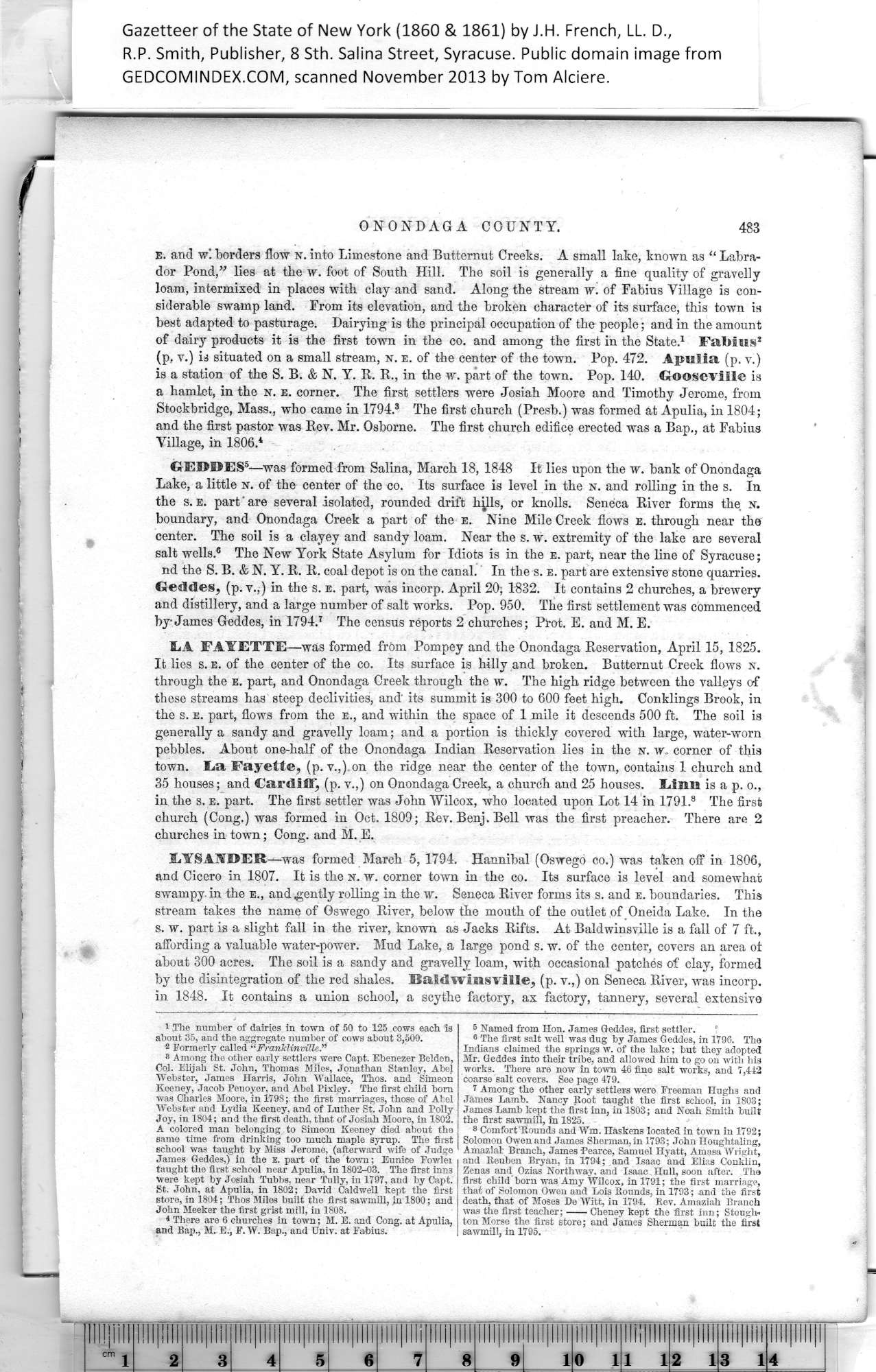|
ONONDAGA COUNTY. 483
E. and w! borders flow n. into Limestone and Butternut Creeks. A small lake, known as “ Labra¬
dor Pond,” lies at the w. foot of South Hill. The soil is generally a fine quality of gravelly
loam, intermixed in places with clay and sand. Along the stream w. of Fabius Village is con¬
siderable swamp land. From its elevation, and the broken character of its surface, this town is
best adapted to pasturage. Dairying is the principal occupation of the people; and in the amount
of dairy products it is the first town in the co. and among the first in the State.1 Fabius*
(p, v.) is situated on a small stream, n. e. of the center of the town. Pop. 472. Apulia (p. v.)
is a station of the S. B. & N. Y. R. R., in the w. part of the town. Pop. 140. Gooseville is
a hamlet, in the n. e. corner. The first settlers were Josiah Moore and Timothy Jerome, from
Stockbridge, Mass., who came in 1794.3 The first church (Presb.) was formed at Apulia, in 1804;
and the first pastor was Rev. Mr. Osborne. The first church edifice erected was a Bap., at Fabius
Village, in 1806*
GEDDES5—was formed from Salina, March 18, 1848 It lies upon the w. bank of Onondaga
Lake, a little n. of the center of the eo. Its surface is level in the n. and rolling in the s. In
the s. E. part' are several isolated, rounded drift hills, or knolls. Seneca River forms the n.
boundary, and Onondaga Creek a part of the e. Nine Mile Creek flows e. through near the
center. The soil is a clayey and sandy loam. Near the s. w. extremity of the lake are several
salt wells.6 The New York State Asylum for Idiots is in the e. part, near the line of Syracuse;
nd the S. B. & N. Y. R. R. coal depot is on the canal. In the s. e. part are extensive stone quarries.
Geddes, (p. v.,) in the s. e. part, was incorp. April 20; 1832. It contains 2 churches, a brewery
and distillery, and a large number of salt works. Pop. 950. The first settlement was commenced
by-James Geddes, in 1794.1 The census reports 2 churches; Prot. B. and M. E.
EA FAYETTE—was formed from Pompey and the Onondaga Reservation, April 15, 1825.
It lies s. e. of the center of the co. Its surface is hilly and broken. Butternut Creek flows n.
through the e. part, and Onondaga Creek through the w. The high, ridge between the valleys o-f
these streams has steep declivities, and' its summit is 300 to 600 feet high. Conklings Brook, in
the s. e. part, flows from the E., and within the space of 1 mile it descends 500 ft. The soil is
generally a sandy and gravelly loam; and a portion is thickly covered with large, water-worn
pebbles. About one-half of the Onondaga Indian Reservation lies in the N. w. corner of this
town. La Fayette, (p.v.,).on the ridge near the center of the town, contains 1 church and
35 houses; and Cardiff, (p. v.,) on Onondaga Creek, a church and 25 houses. Llnil is a p. o.,
in the s. e. part. The first settler was John Wilcox, who located upon Lot 14 in 1791.8 The first
church (Cong.) was formed in Oct. 1809; Rev. Benj. Bell was the first preacher. There are 2
churches in town; Cong, and M. E.
EYSANDEM—was formed March 5, 1794. Hannibal (Oswego co.) was taken off in 1806,
and Cicero in 1807. It is the n. w. corner town in the co. Its surface is level and somewhat
swampy, in the e., and .gently rolling in the w. Seneca River forms its s. and e. boundaries. This
stream takes the name of Oswego River, below the mouth of the outlet of Oneida Lake. In the
s. w. part is a slight fall in the river, known as Jacks Rifts. At Baldwinsviile is a fall of 7 ft.,
affording a valuable water-power. Mud Lake, a large pond s. w. of the center, covers an area ot
about 300 acres. The soil is a sandy and gravelly loam, with occasional patches of clay, formed
by the disintegration of the red shales. ISaidwmsville, (p. v.,) on Seneca River, was incorp.
in 1848. It contains a union school, a scythe factory, ax factory, tannery, several extensive
|
s Named from Hon. James Geddes, first settler. '
6 The first salt well was dug hy James Geddes, in 1796. The
Indians claimed the springs w. of the lake; hut they adopted
Mr. Geddes into their tribe, and allowed him to go on with his
works. There are now in town 46 fine salt works, and 7,442
coarse salt covers. See page 479.
7 Among the other early settlers were Freeman Hughs and
James Lamb. Nancy Root taught the first school, in 1803;
James Lamb kept the first inn, in 1803; and Noah Smith built
the first sawmill, in 1825.
8 Comfort'Rounds and Wm. Haskens located in town in 1792;
Solomon Owen and James Sherman, in 1793; John Houghtaling,
Amaziat Branch, James -Pearce, Samuel Hyatt, Amasa Wright,
and Reuben Bryan, in 1794; and Isaac and Elias Conklin,
Zenas and Ozias Northway, and Isaac Hull, soon after. The
first child born was Amy Wilcox, in 1791; the first marriage,
that of Solomon Owen and Lois Rounds, in 1793; and the first
death, that of Moses De Witt, in 1794. Rev. Amaziah Branch
was the first teacher; Cheney kept the first inn; Stough¬
ton Morse the first store; and James Sherman built the first
sawmill, in 1795. |
1
St. John, at Apulia, in 1802; David Caldwell kept the first
store, in 1804; Thos Miles built the first sawmill, in 1800; and
John Meeker the first grist mill, in 1808.
|
